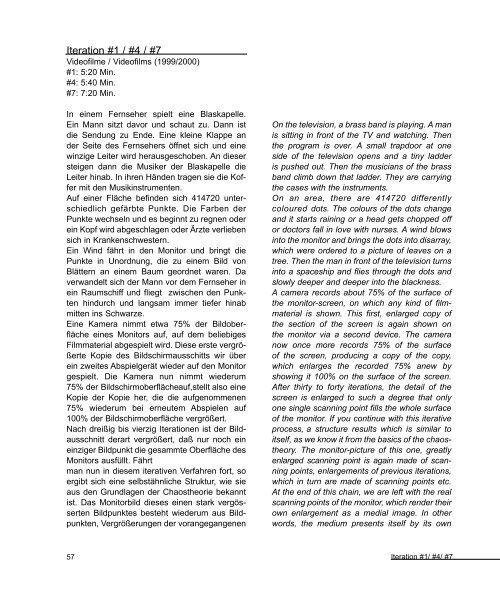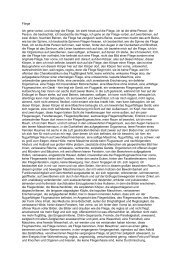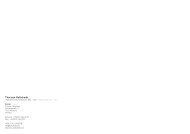Erfolgreiche ePaper selbst erstellen
Machen Sie aus Ihren PDF Publikationen ein blätterbares Flipbook mit unserer einzigartigen Google optimierten e-Paper Software.
Iteration #1 / #4 / #7<br />
Videofilme / Videofilms (1999/2000)<br />
#1: 5:20 Min.<br />
#4: 5:40 Min.<br />
#7: 7:20 Min.<br />
In einem Fernseher spielt eine Blaskapelle.<br />
Ein Mann sitzt davor und schaut zu. Dann ist<br />
die Sendung zu Ende. Eine kleine Klappe an<br />
der Seite des Fernsehers öffnet sich und eine<br />
winzige Leiter wird herausgeschoben. An dieser<br />
steigen dann die Musiker der Blaskapelle die<br />
Leiter hinab. In ihren Händen tragen sie die Koffer<br />
mit den Musikinstrumenten.<br />
Auf einer Fläche befinden sich 414720 unterschiedlich<br />
gefärbte Punkte. Die Farben der<br />
Punkte wechseln und es beginnt zu regnen oder<br />
ein Kopf wird abgeschlagen oder Ärzte verlieben<br />
sich in Krankenschwestern.<br />
Ein Wind fährt in den Monitor und bringt die<br />
Punkte in Unordnung, die zu einem Bild von<br />
Blättern an einem Baum geordnet waren. Da<br />
verwandelt sich der Mann vor dem Fernseher in<br />
ein Raumschiff und fliegt zwischen den Punkten<br />
hindurch und langsam immer tiefer hinab<br />
mitten ins Schwarze.<br />
Eine Kamera nimmt etwa 75% der Bildoberfläche<br />
eines Monitors auf, auf dem beliebiges<br />
Filmmaterial abgespielt wird. Diese erste vergrößerte<br />
Kopie des Bildschirmausschitts wir über<br />
ein zweites Abspielgerät wieder auf den Monitor<br />
gespielt. Die Kamera nun nimmt wiederum<br />
75% der Bildschirmoberfläche auf, stellt also eine<br />
Kopie der Kopie her, die die aufgenommenen<br />
75% wiederum bei erneutem Abspielen auf<br />
100% der Bildschirmoberfläche vergrößert.<br />
Nach dreißig bis vierzig Iterationen ist der Bildausschnitt<br />
derart vergrößert, daß nur noch ein<br />
einziger Bildpunkt die gesammte Oberfläche des<br />
Monitors ausfüllt. Fährt<br />
man nun in diesem iterativen Verfahren fort, so<br />
ergibt sich eine selbstähnliche Struktur, wie sie<br />
aus den Grundlagen der Chaostheorie bekannt<br />
ist. Das Monitorbild dieses einen stark vergösserten<br />
Bildpunktes besteht wiederum aus Bildpunkten,<br />
Vergrößerungen der vorangegangenen<br />
57<br />
On the television, a brass band is playing. A man<br />
is sitting in front of the TV and watching. Then<br />
the program is over. A small trapdoor at one<br />
side of the television opens and a tiny ladder<br />
is pushed out. Then the musicians of the brass<br />
band climb down that ladder. They are carrying<br />
the cases with the instruments.<br />
On an area, there are 414720 differently<br />
coloured dots. The colours of the dots change<br />
and it starts raining or a head gets chopped off<br />
or doctors fall in love with nurses. A wind blows<br />
into the monitor and brings the dots into disarray,<br />
which were ordered to a picture of leaves on a<br />
tree. Then the man in front of the television turns<br />
into a spaceship and flies through the dots and<br />
slowly deeper and deeper into the blackness.<br />
A camera records about 75% of the surface of<br />
the monitor-screen, on which any kind of filmmaterial<br />
is shown. This first, enlarged copy of<br />
the section of the screen is again shown on<br />
the monitor via a second device. The camera<br />
now once more records 75% of the surface<br />
of the screen, producing a copy of the copy,<br />
which enlarges the recorded 75% anew by<br />
showing it 100% on the surface of the screen.<br />
After thirty to forty iterations, the detail of the<br />
screen is enlarged to such a degree that only<br />
one single scanning point fills the whole surface<br />
of the monitor. If you continue with this iterative<br />
process, a structure results which is similar to<br />
itself, as we know it from the basics of the chaostheory.<br />
The monitor-picture of this one, greatly<br />
enlarged scanning point is again made of scanning<br />
points, enlargements of previous iterations,<br />
which in turn are made of scanning points etc.<br />
At the end of this chain, we are left with the real<br />
scanning points of the monitor, which render their<br />
own enlargement as a medial image. In other<br />
words, the medium presents itself by its own<br />
Iteration #1/ #4/ #7




